Hydrological Responses to Land Use Land Cover Changes in the Fincha’a Watershed, Ethiopia
Abstract
:1. Introduction
2. Materials and Methods
2.1. Study Area
2.1.1. Watershed Topography and Geology
2.1.2. Weather Data
2.1.3. Temperature
2.1.4. Rainfall
2.1.5. Evaporation
2.1.6. Soil Type
2.2. Spatial Data and Satellite Imagery
2.2.1. Digital Elevation Model
2.2.2. Landsat Imagery
2.3. Image Classification Process
Supervised Classification
- Cultivated Land: Areas used for crop cultivation, both annuals and perennials, and the scattered rural settlements that are closely associated with the cultivated fields.
- Bare Soil: Areas covered with soil surfaces and sand with no vegetation cover or uncultivated farmlands consisting of exposed soil and rock outcrops.
- Forest Land: Land covered with dense trees which include evergreen forest land, mixed forest, and sparse trees.
- Shrub Land: Land covered with open shrubs, closed shrubs, bushes, and mixed with small trees.
- Grass Land: Areas covered with grass used for grazing, as well as bare lands that have little grass or no grass cover. It also includes other small-sized plant species.
- Settlement: Area covered with building rural residential houses infrastructures roads.
- Waterbody: Waterlogged areas and lakes throughout the year, the rivers, and their main tributaries.
- Wetlands: An area that is saturated with water, either permanently or seasonally waterlogged around a swamp area.
2.4. Hydrological Modelling with SWAT
2.4.1. Model Setup
2.4.2. Watershed Delineation
2.4.3. Hydrologic Response Units
2.4.4. Weather Data
2.4.5. Sensitivity Analysis
2.4.6. Calibration and Validation
2.4.7. Model Performance Evaluation
3. Results and Discussion
3.1. Land Use Land Cover Changes
3.2. Land Use Classification Accuracy
3.3. Calibration and Validation of the Streamflow
3.4. Hydrological Response to LULCC Changes on Streamflow
3.5. Sensitivity Analysis
3.6. Recommendations
- No gauging stations are yet installed in the lower part of the Fincha’a watershed, while some of them are installed in the upper part. For the future, greater efforts are needed to install stations evenly distributed in the watershed, aiming to obtain a better monitoring network, which can be used for inferring basin-wide information on the hydro-meteorological dynamics.
- At this moment, there is a reduced agreement on the watershed delineation. In fact, for defining the basin borders, some researchers used the outlet of the Chomen Lake, while others prefer the right bank of the Abbay River. This can result in dissimilarities and uncertainties between the results of studies such as the one presented here, and foster a debate among researchers. To solve the situation, the Abbay Basin Authority office should give a clear description of watershed delineation, support decisions, and update information by re-organizing the management information system.
- To develop more accurate hydrological models such as the one shown here, improved monitoring devices and protocols are needed. Indeed, the present gauging network does not allow for developing a precise and basin-wide water use budget, knowing, for example, how much water of the reservoir is used for domestic uses or irrigation.
- The great expansion of cultivated land exposes the local community to cutting trees for fuel, construction of timber, and generation of additional income, but negatively affects the natural environment. However, it could be better to wisely use the natural resources, managing them in an integrated, participatory, equitable, and sustainable manner.
- For the future, there is the need of integrating similar studies of LULCC with research looking at the effect of LULCC on the natural capital (see, for example, [53]), for public awareness and decision-making processes at the watershed level for sustainable development.
- If the past trends in LULCC will persist in the future, the observed increase in surface runoff and peak events, as well as soil erosion, could be eventually fostered by climate change, with unforeseen consequences on the environment [54] and the local livelihood [55,56]. Therefore, there is the need for further research, accounting for not only the most up-to-date climate scenarios but also the interrelationship between the natural and the built environment.
- Differently from anthropogenic drivers, natural variations such as climate change affect the environment and the connected ecosystem services at a longer time scale [36,37,38], and therefore future studies should consider longer horizons to effectively account for the combined effects of both natural and human-induced alterations.
4. Conclusions
Author Contributions
Funding
Data Availability Statement
Acknowledgments
Conflicts of Interest
References
- Abbott, M.B.; Refsgaard, J.C. (Eds.) Distributed Hydrological Modelling; Springer Science & Business Media: Dordrecht, The Netherlands, 2012; Volume 22. [Google Scholar]
- Butchart, S.; Walpole, M.; Collen, B.; Van Strien, A.; Scharlemann, J.; Almond, R.; Baillie, J.E.; Bomhard, B.; Brown, C.; Bruno, J.; et al. Global biodiversity: Indicators of recent declines. Science 2010, 328, 1164–1168. [Google Scholar] [CrossRef]
- Githui, F.; Mutua, F.; Bauwens, W. Estimating the impacts of land cover change on runoff using the soil and water assessment tool (SWAT): Case study of Nzoia catchment, Kenya. Hydrol. Sci. J. 2010, 54, 899–908. [Google Scholar] [CrossRef]
- Kennedy, R.E.; Yang, Z.; Braaten, J.; Copass, C.; Antonova, N.; Jordan, C.; Nelson, P. Attribution of disturbance change agent from Landsat time-series in support of habitat monitoring in the Puget Sound region, USA. Remote Sens. Environ. 2015, 166, 271–285. [Google Scholar] [CrossRef]
- Li, M.S.; Mao, L.J.; Shen, W.J.; Liu, S.Q.; Wei, A.S. Change and fragmentation trends of Zhanjiang mangrove forests in southern China using multi-temporal Landsat imagery (1977–2010). Estuar. Coast. Shelf Sci. 2013, 130, 111–120. [Google Scholar] [CrossRef]
- Kamwi, J.; Cho, M.; Kaetsch, C.; Manda, S.; Graz, F.; Chirwa, P. Assessing the Spatial Drivers of Land Use and Land Cover Change in the Protected and Communal Areas of the Zambezi Region, Namibia. Land 2018, 7, 131. [Google Scholar] [CrossRef] [Green Version]
- Vermote, E.; Justice, C.; Claverie, M.; Franch, B. Preliminary analysis of the performance of the Landsat 8/OLI land surface reflectance product. Remote Sens. Environ. 2016, 185, 46–56. [Google Scholar] [CrossRef]
- Souza-Filho, P.W.M.; de Souza, E.B.; Silva Júnior, R.O.; Nascimento, W.R., Jr.; de Mendonça, B.R.V.; Guimarães, J.T.F.; Dall’Agnol, R.; Siqueira, J.O. Four decades of land-cover, land-use and hydroclimatology changes in the Itacaiúnas River watershed, southeastern Amazon. J. Environ. Manag. 2016, 167, 175–184. [Google Scholar] [CrossRef] [PubMed]
- Shen, G.; Ibrahim, A.N.; Wang, Z.; Ma, C.; Gong, J. Spatial—Temporal land-use/land-cover dynamics and their impacts on surface temperature in Chongming Island of Shanghai, China. Int. J. Remote Sens. 2015, 36, 4037–4053. [Google Scholar] [CrossRef]
- Park, J.K.; Um, D.Y. Time series analysis of land cover and land surface temperature change using remote sensing method in Seoul. Int. J. Appl. Eng. Res. 2015, 10, 39201–39207. [Google Scholar]
- Dissanayake, S.; Asafu-Adjaye, J.; Mahadeva, R. Addressing climate change cause and effect on land cover and land use in South Asia. Land Use Policy 2017, 67, 352–366. [Google Scholar] [CrossRef]
- Calder, C. Hydrologic effects of land use change. In Handbook of Hydrology; Maidment, D.R., Ed.; McGraw-Hill: New York, NY, USA, 1993. [Google Scholar]
- Garg, V.; Nikam, B.R.; Thakur, P.K.; Aggarwal, S.P.; Gupta, P.K.; Srivastav, S.K. Human-induced land use land cover change and its impact on hydrology. HydroResearch 2019, 1, 48–56. [Google Scholar] [CrossRef]
- Alam, A.; Bhat, M.S.; Maheen, M. Using Landsat satellite data for assessing the land use and land cover change in Kashmir valley. GeoJournal 2020, 85, 1529–1543. [Google Scholar] [CrossRef] [Green Version]
- Leta, M.K.; Demissie, T.A.; Tränckner, J. Modeling and Prediction of Land Use Land Cover Change Dynamics Based on Land Change Modeler (LCM) in Nashe Watershed, Upper Blue Nile Basin, Ethiopia. Sustainability 2021, 13, 3740. [Google Scholar] [CrossRef]
- Zoungrana, B.J.; Conrad, C.; Amekudzi, L.K.; Thiel, M.; Da, E.D.; Forkuor, G.; Löw, F. Multi-temporal landsat images and ancillary data for land use/cover change (LULCC) detection in the Southwest of Burkina Faso, West Africa. Remote Sens. 2015, 7, 12076–12102. [Google Scholar] [CrossRef] [Green Version]
- Di Gregorio, A.D.; Jansen, L.J. Land Cover Classification System, Classification Concepts and User Manual, Software version 2; Food and Agriculture Organization of the United Nations: Rome, Italy, 2005. [Google Scholar]
- Regasa, M.S.; Nones, M.; Adeba, D. A Review on Land Use and Land Cover Change in Ethiopian Basins. Land 2021, 10, 585. [Google Scholar] [CrossRef]
- Desta, H.; Fetene, A. Land-use and land-cover change in Lake Ziway watershed of the Ethiopian Central Rift Valley Region and its environmental impacts. Land Use Policy 2020, 96, 104682. [Google Scholar] [CrossRef]
- Dwivedi, R.S.; Sreenivas, K.; Ramana, K.V. Cover: Land-use/land-cover change analysis in part of Ethiopia using Landsat Thematic Mapper data. Int. J. Remote. Sens. 2005, 26, 1285–1287. [Google Scholar] [CrossRef]
- Meyer, W.B.; Turner, B.L., II. Change in Land Use and Land Cover: A Global Perspective; Cambridge University Press: Cambridge, MA, USA, 1994; 537p. [Google Scholar]
- Lambin, E.F.; Turner, B.L.; Geist, H.J.; Agbola, S.B.; Angelsen, A.; Bruce, J.W.; Coomes, O.T.; Dirzog, R.; Fischerh, G.; Folke, C.; et al. The causes of land-use and land-cover change: Moving beyond the myths. Glob. Environ. Chang. 2001, 11, 261–269. [Google Scholar] [CrossRef]
- Anderson, J.H. A Land Use and Land Cover Classification System for Use with Remote Sensor Data; Geological Survey Professional Paper; US Government Printing Office: Washington, DC, USA, 1976; Volume 964. [Google Scholar]
- Zhang, L.; Nan, Z.; Yu, W.; Ge, Y. Hydrological responses to land-use change scenarios under constant and changed climatic conditions. Environ. Manag. 2016, 57, 412–431. [Google Scholar] [CrossRef]
- Cüceloğlu, G.; Seker, D.Z.; Tanik, A.; Öztürk, İ. Analyzing Effects of Two Different Land Use Datasets on Hydrological Simulations by Using SWAT Model. Int. J. Environ. Geoinform. 2021, 8, 172–185. [Google Scholar] [CrossRef]
- Polanco, E.I.; Fleifle, A.; Ludwig, R.; Disse, M. Improving SWAT model performance in the upper Blue Nile Basin using meteorological data integration and subcatchment discretization. Hydrol. Earth Syst. Sci. 2017, 21, 4907–4926. [Google Scholar] [CrossRef] [Green Version]
- de Serrão, E.A.O.; Silva, M.T.; Ferreira, T.R.; de Ataide, L.C.P.; dos Santos, C.A.; de Lima, A.M.M.; Gomes, D.J.C. Impacts of land use and land cover changes on hydrological processes and sediment yield determined using the SWAT model. Int. J. Sediment Res. 2021, in press. [Google Scholar]
- Markhi, A.; Laftouhi, N.; Grusson, Y.; Soulaimani, A. Assessment of potential soil erosion and sediment yield in the semi-arid N′ fis basin (High Atlas, Morocco) using the SWAT model. Acta Geophys. 2019, 67, 263–272. [Google Scholar] [CrossRef]
- Negese, A. Impacts of Land Use and Land Cover Change on Soil Erosion and Hydrological Responses in Ethiopia. Appl. Environ. Soil Sci. 2021, in press. [Google Scholar] [CrossRef]
- Worku, T.; Khare, D.; Tripathi, S.K. Modeling runoff–sediment response to land use/land cover changes using integrated GIS and SWAT model in the Beressa watershed. Environ. Earth Sci. 2017, 76, 1–14. [Google Scholar] [CrossRef]
- Ethiopian Water Resources Management Policy. 1999. Available online: http://www.fao.org/faolex/results/details/en/c/LEX-FAOC158196 (accessed on 1 April 2021).
- Moriasi, D.N.; Arnold, J.G.; Van Liew, M.W.; Bingner, R.L.; Harmel, R.D.; Veith, T.L. Model evaluation guidelines for systematic quantification of accuracy in watershed simulations. Trans. ASABE 2007, 50, 885–900. [Google Scholar] [CrossRef]
- Leta, M.K.; Demissie, T.A.; Koriche, S.A. Impacts of Land Use Land Cover Change on Sediment Yield and Stream Flow: A Case of Finchaa Hydropower Reservoir, Ethiopia. Int. J. Sci. Technol. 2017, 6, 763–781. [Google Scholar]
- Berihun, M.L.; Tsunekawa, A.; Haregeweyn, N.; Meshesha, D.T.; Adgo, E.; Tsubo, M.; Masunaga, T.; Fenta, A.A.; Sultan, D.; Yibeltal, M.; et al. Hydrological responses to land use/land cover change and climate variability in contrasting agro-ecological environments of the Upper Blue Nile basin, Ethiopia. Sci. Total. Environ. 2019, 689, 347–365. [Google Scholar] [CrossRef]
- Warburton, M.L.; Schulze, R.E.; Jewitt, G.P. Hydrological impacts of land use change in three diverse South African catchments. J. Hydrol. 2012, 414, 118–135. [Google Scholar] [CrossRef]
- Tessema, I.; Simane, B. Vulnerability analysis of smallholder farmers to climate variability and change: An agro-ecological system-based approach in the Fincha’a sub-basin of the upper Blue Nile Basin of Ethiopia. Ecol. Process. 2019, 8, 1–18. [Google Scholar] [CrossRef] [Green Version]
- Tefera, B.; Sterk, G. Hydropower-induced land use change in Fincha’a watershed, western Ethiopia: Analysis and impacts. Mt. Res. Dev. 2008, 28, 72–80. [Google Scholar] [CrossRef] [Green Version]
- Dibaba, W.T.; Demissie, T.A.; Miegel, K. Drivers and implications of land use/land cover dynamics in Finchaa catchment, northwestern Ethiopia. Land 2020, 9, 113. [Google Scholar] [CrossRef] [Green Version]
- Prabhadevi, Y.G.K.L.; Sreenivasa, V.; Mengistou, S. A Study on Phytoplankton Species Composition, and Primary Production in Fincha Reservoir, West Shoa Zone, Ethiopia. J. Nat. Sci. Res. 2015, 5, 23–30. [Google Scholar]
- Bezuayehu, T. People and dams: Environmental and socio-economic impact Fincha’a Hydropower dam, western Ethiopia. Trop. Res. Manag. Papers 2006, 75, Wageningen University, Wageningen, the Netherlands. [Google Scholar]
- Makin, M.K. Prospects for Irrigation Development around Lake Ziway, Ethiopia. Land Resour. Study Div. 1976, 26, 1–132. [Google Scholar]
- Natural Resources Conservation Service; Agriculture Department (Eds.) Keys to Soil Taxonomy; Government Printing Office: Washington, DC, USA, 2010. [Google Scholar]
- Gyanesh, C.; Brian, L.M.; Dennis, L.H. Summary of current radiometric calibration coefficients for Landsat MSS, TM, ETM+, and EO–1 ALI sensors. Remote. Sens. Environ. 2009, 113, 893–903. [Google Scholar]
- Tamiru, H.; Wagari, M. Comparison of ANN model and GIS tools for Delineation of Groundwater Potential Zones, Fincha Catchment, Abay Basin, Ethiopia. Geocarto Int. 2021, 1–13, accepted. [Google Scholar] [CrossRef]
- Taye, H. Dynamics of Land Use Land Cover Changes on Stream Flow in Fincha Amerti Neshe Sub-Basin. Master’s Thesis, School of Graduate Studies of Addis Abeba University, Addis Abeba, Ethiopia, 2016. [Google Scholar]
- Campbell, W.G.; Mortenson, D.C. Ensuring the quality of geographic information System data: A practical application of quality control. Photogramm. Eng. Remote. Sens. 1989, 55, 1613–1618. [Google Scholar]
- Setegn, S.G.; Srinivasan, R.; Dargahi, B.; Melesse, A.M. Spatial delineation of soil erosion vulnerability in the Lake Tana Basin, Ethiopia. Hydrol. Process. Int. J. 2009, 23, 3738–3750. [Google Scholar] [CrossRef]
- Danuso, F. A Stochastic Model for weather data generation. Ital. J. Agron. 2002, 6, 57–72. [Google Scholar]
- Arnold, J.G.; Srinivasan, R.; Muttiah, R.R.; Williams, J.R. Large Area Hydrologic Modeling and Assessment Part I: Model Develop. J. Am. Water Resour. Assoc. 1998, 34, 73–89. [Google Scholar] [CrossRef]
- Ayana, A.B.; Edossa, D.C.; Kositsakulchai, E. Simulation of sediment yield using SWAT model in Fincha Watershed, Ethiopia. Agric. Nat. Resour. 2012, 46, 283–297. [Google Scholar]
- Da Silva, M.G.; de Aguiar Netto, A.D.O.; de Jesus Neves, R.J.; Do Vasco, A.N.; Almeida, C.; Faccioli, G.G. Sensitivity analysis and calibration of hydrological modeling of the watershed Northeast Brazil. J. Environ. Prot. 2015, 6, 837. [Google Scholar] [CrossRef] [Green Version]
- Tolessa, T.; Kidane, M.; Bezie, A. Assessment of the linkages between ecosystem service provision and land use/land cover change in Fincha watershed, North-Western Ethiopia. Heliyon 2021, 7, e07673. [Google Scholar] [CrossRef]
- Müller-Mahn, D.; Gebreyes, M. Controversial connections: The water-energy-food nexus in the Blue Nile basin of Ethiopia. Land 2019, 8, 135. [Google Scholar] [CrossRef] [Green Version]
- Kumar, S.; Mishra, A. Critical erosion area identification based on hydrological response unit level for effective sedimentation control in a river basin. Water Resour. Manag. 2015, 29, 1749–1765. [Google Scholar] [CrossRef]
- Chimdessa, K.; Quraishi, S.; Kebede, A.; Alamirew, T. Effect of land use land cover and climate change on river flow and soil loss in Didessa River Basin, South West Blue Nile, Ethiopia. Hydrology 2019, 6, 2. [Google Scholar] [CrossRef] [Green Version]
- Dibaba, W.T.; Demissie, T.A.; Miegel, K. Prioritization of Sub-Watersheds to Sediment Yield and Evaluation of Best Management Practices in Highland Ethiopia, Finchaa Catchment. Land 2021, 10, 650. [Google Scholar] [CrossRef]
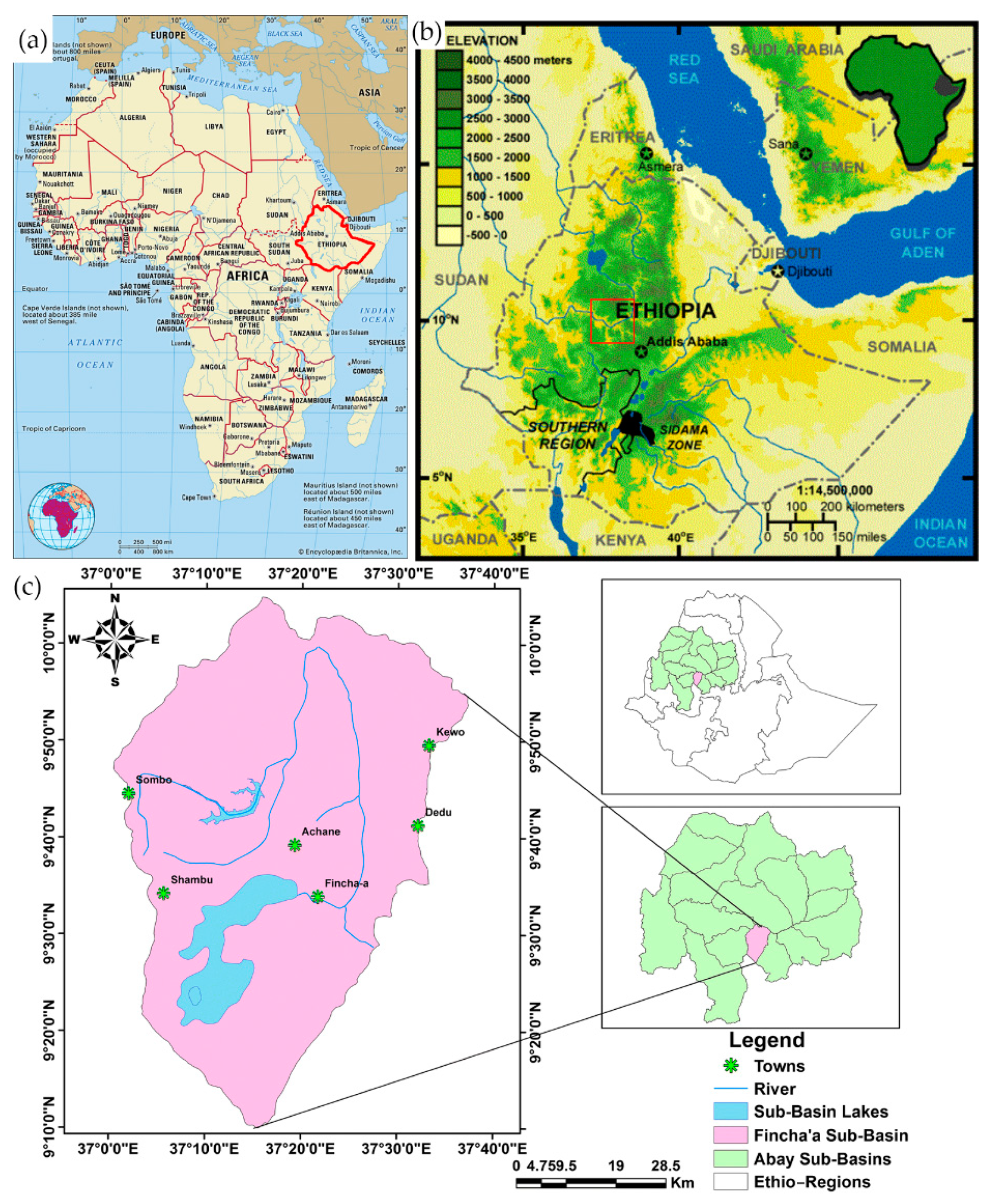
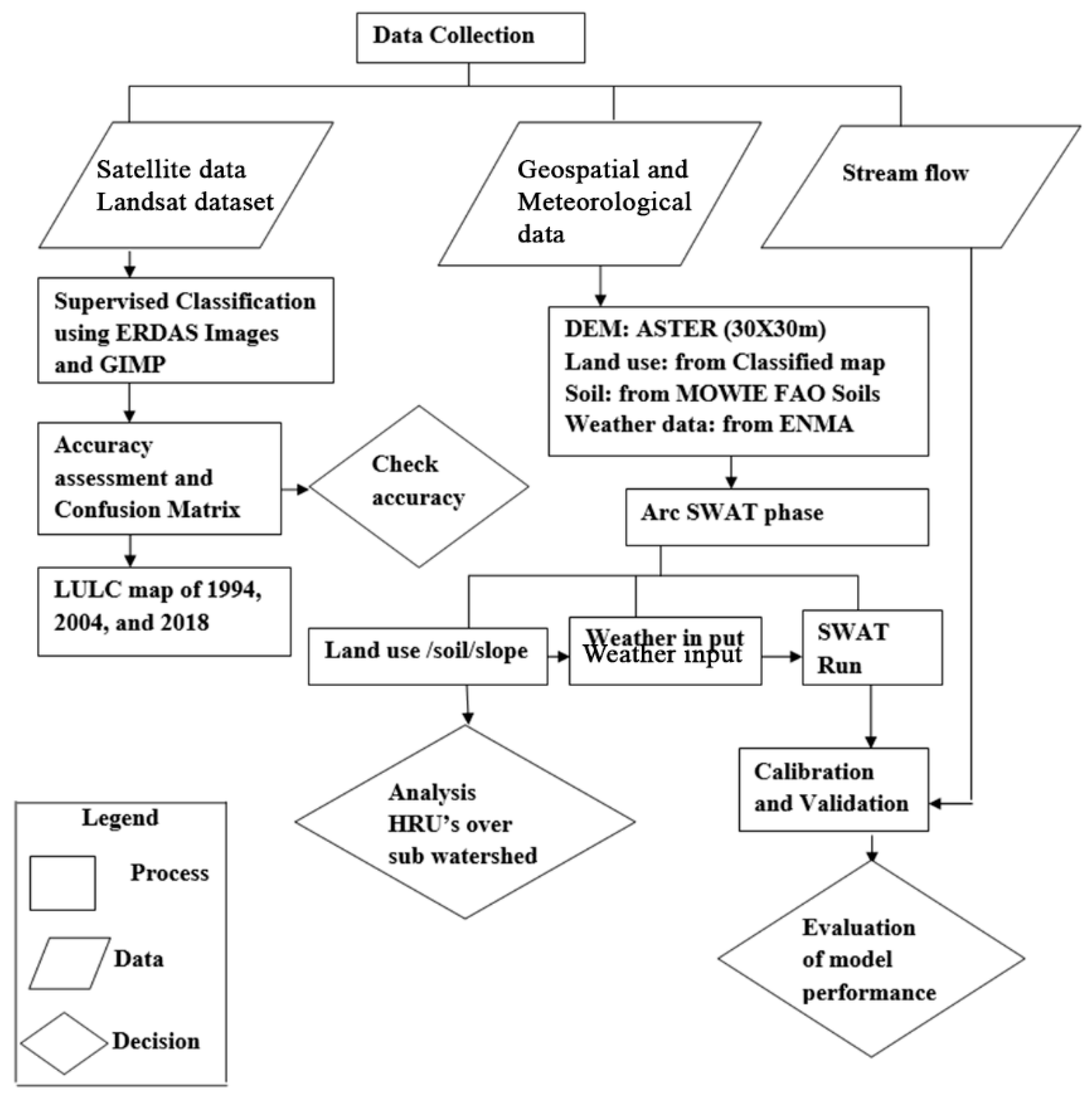
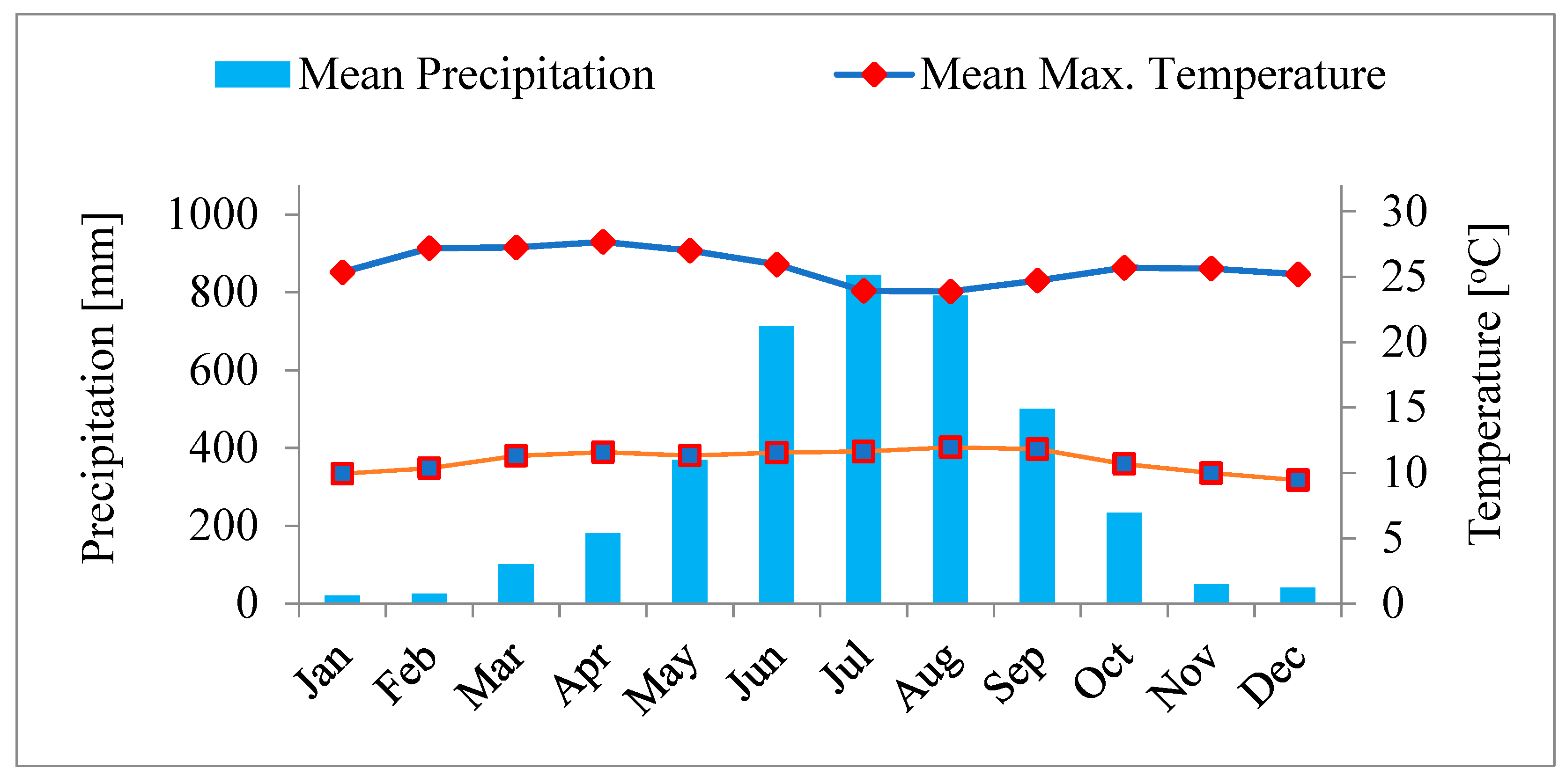

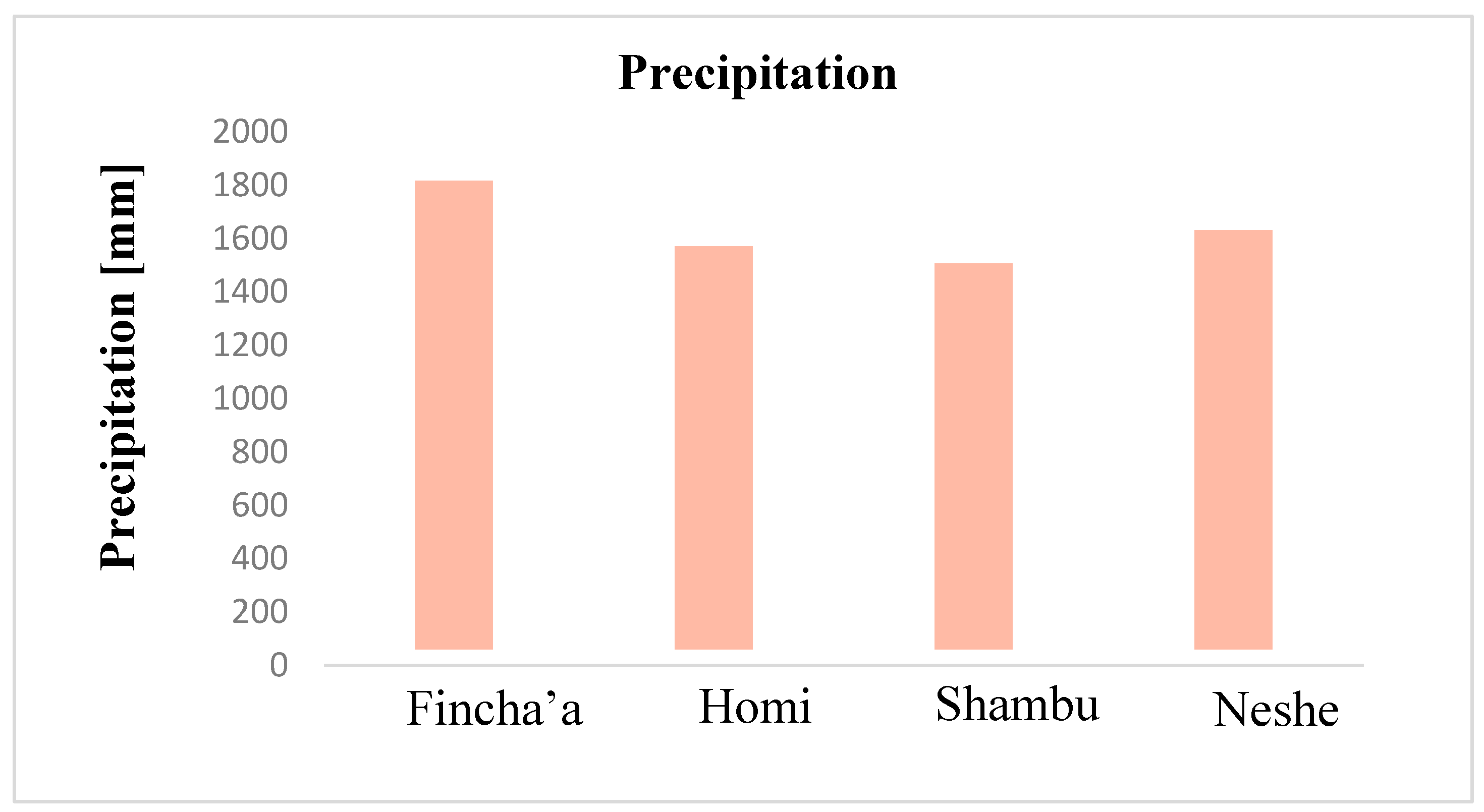
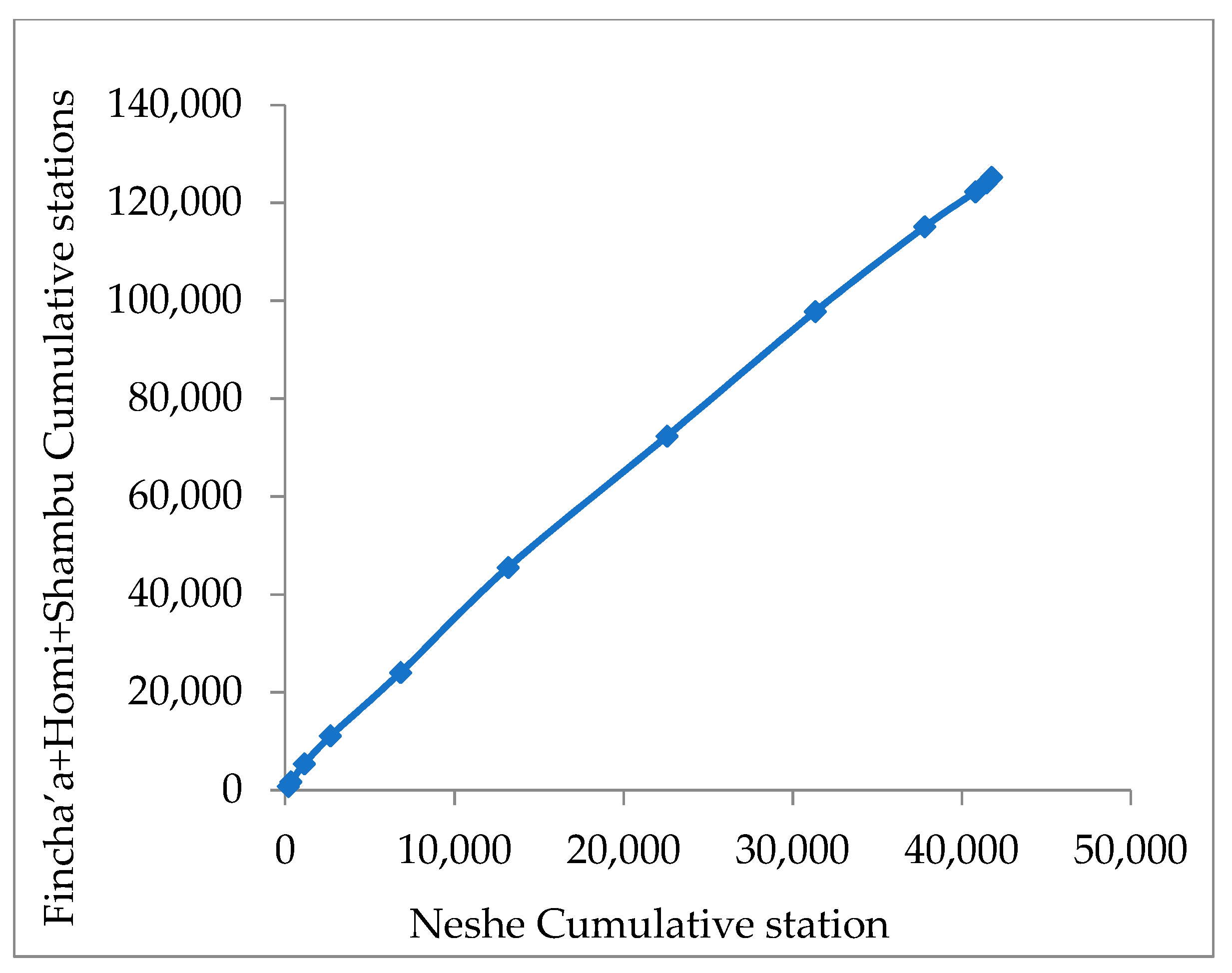
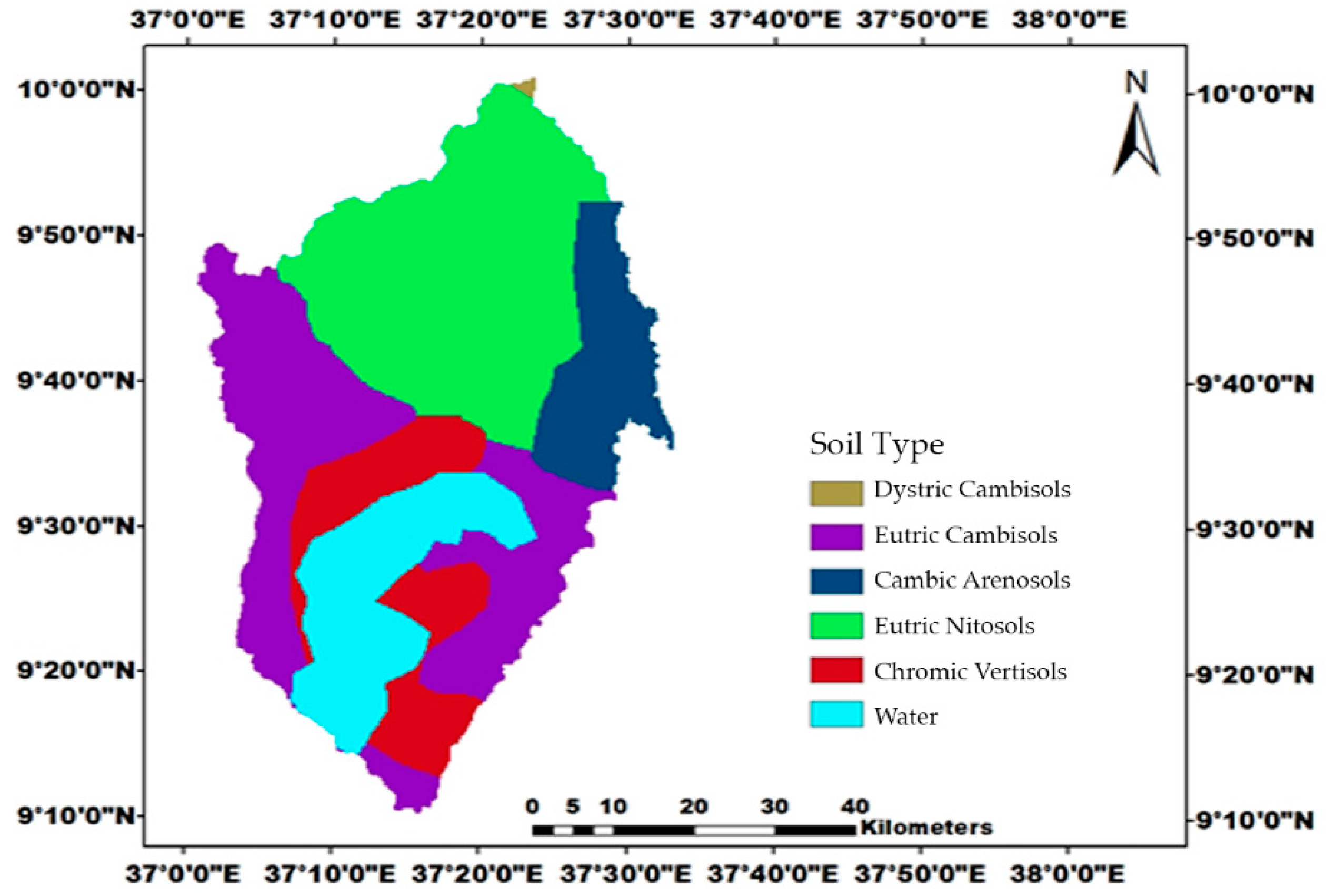
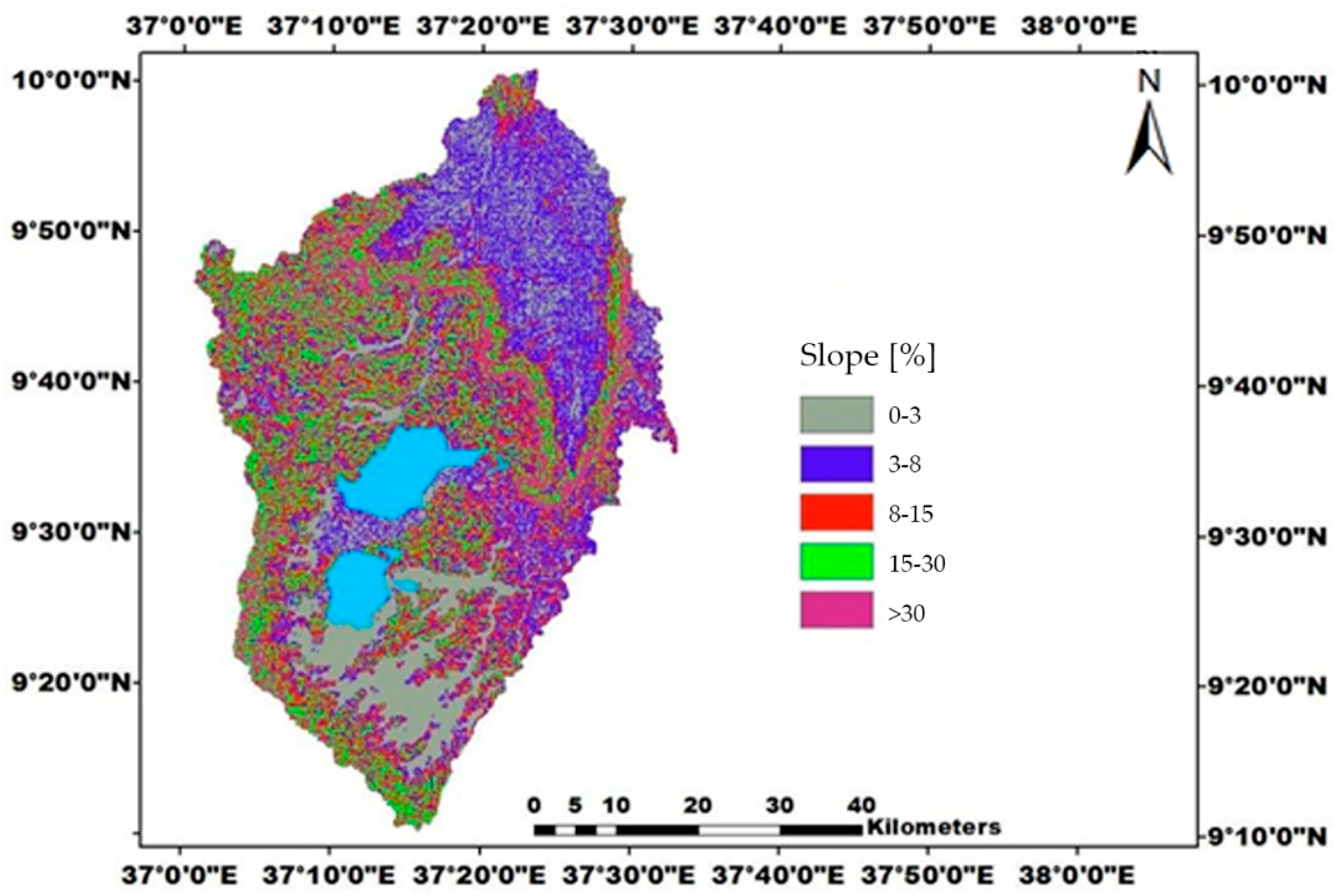
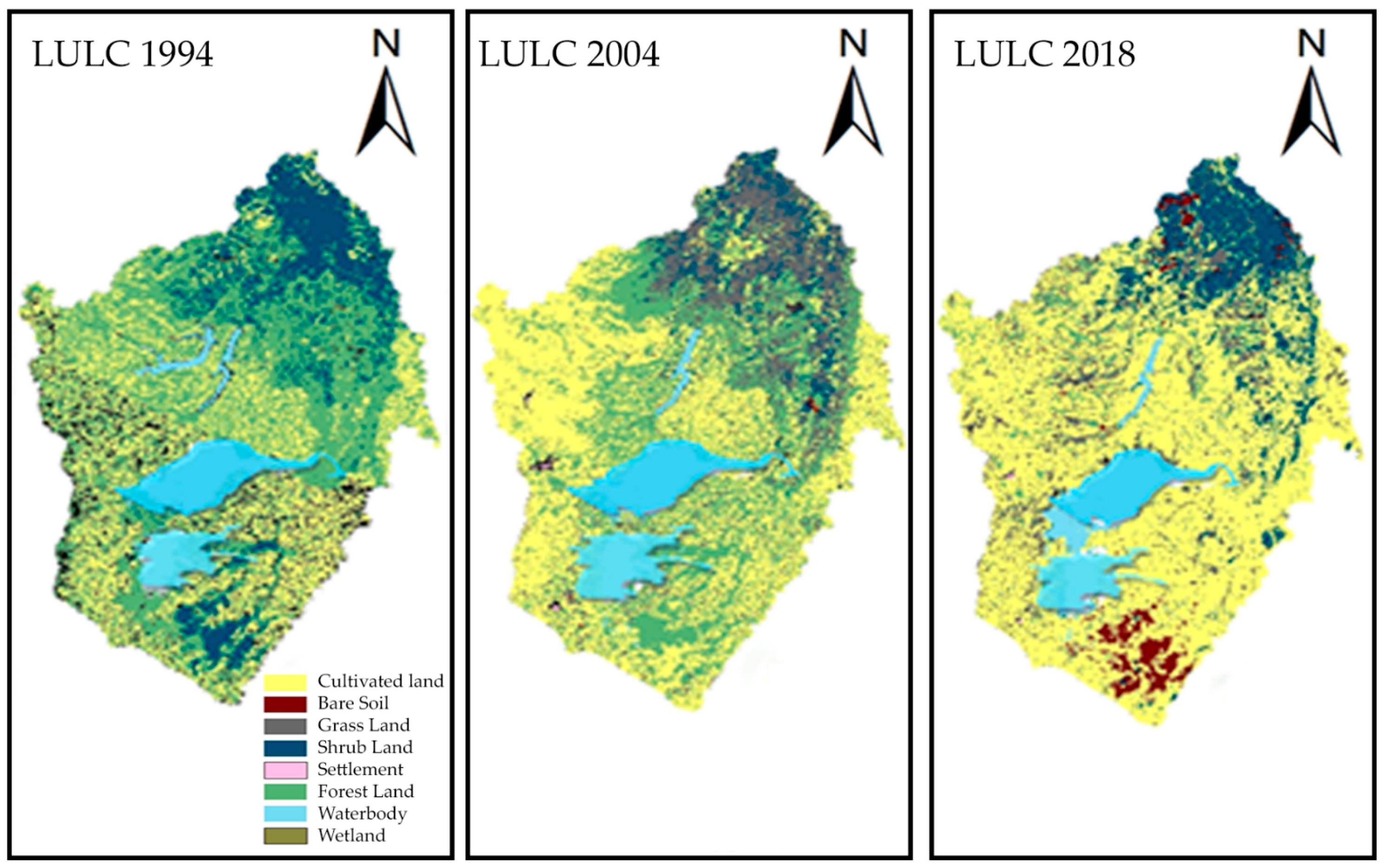
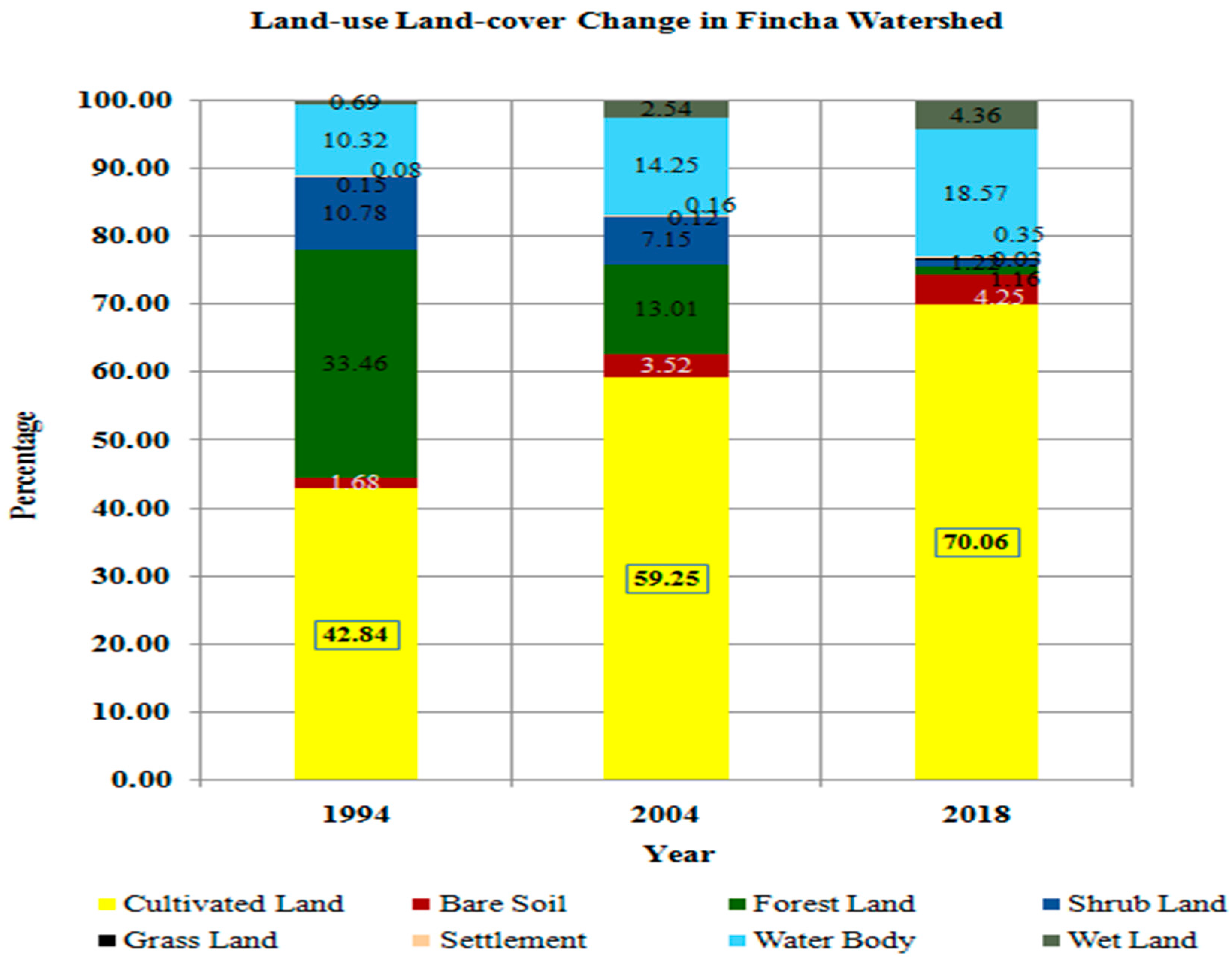
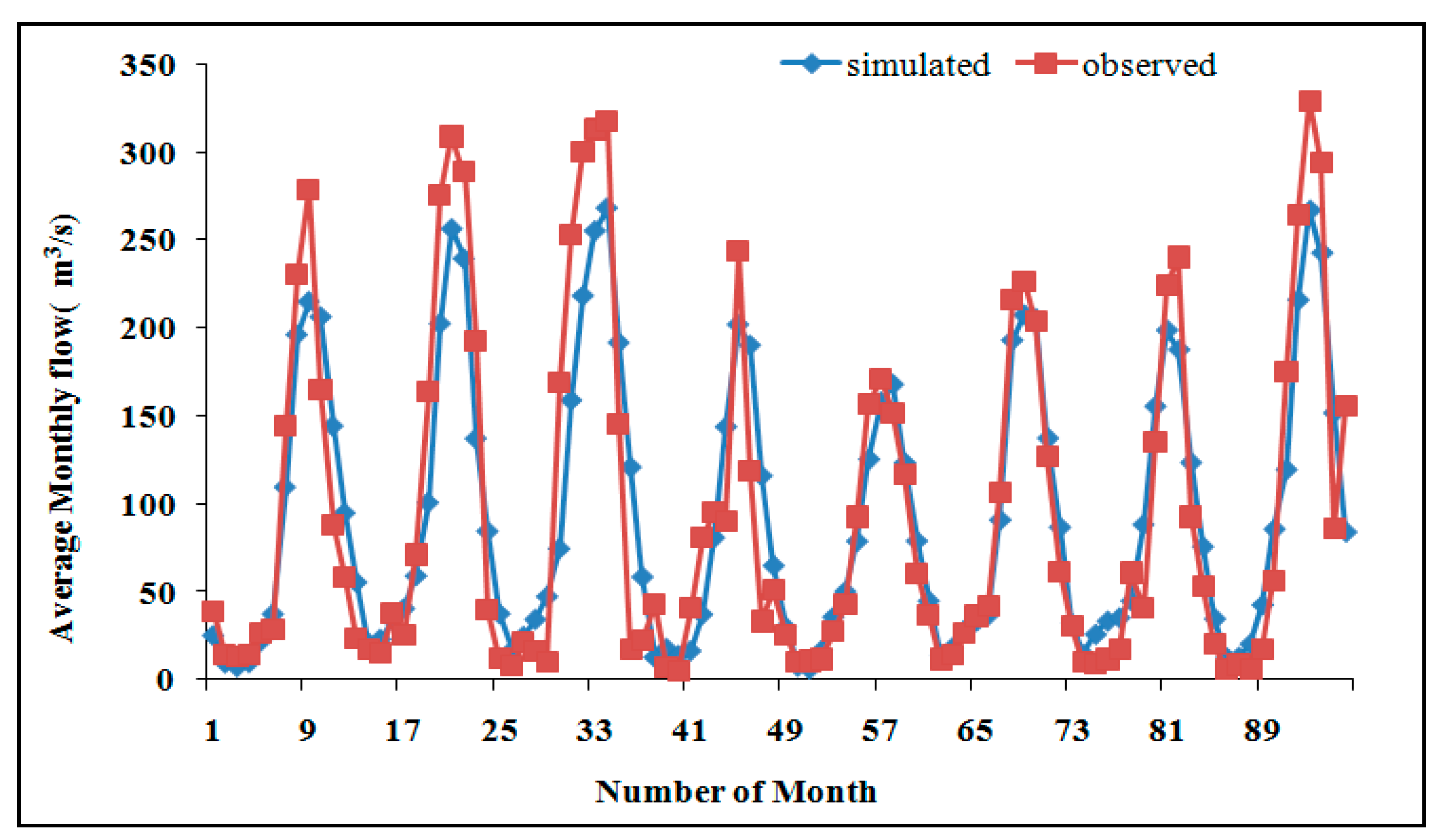
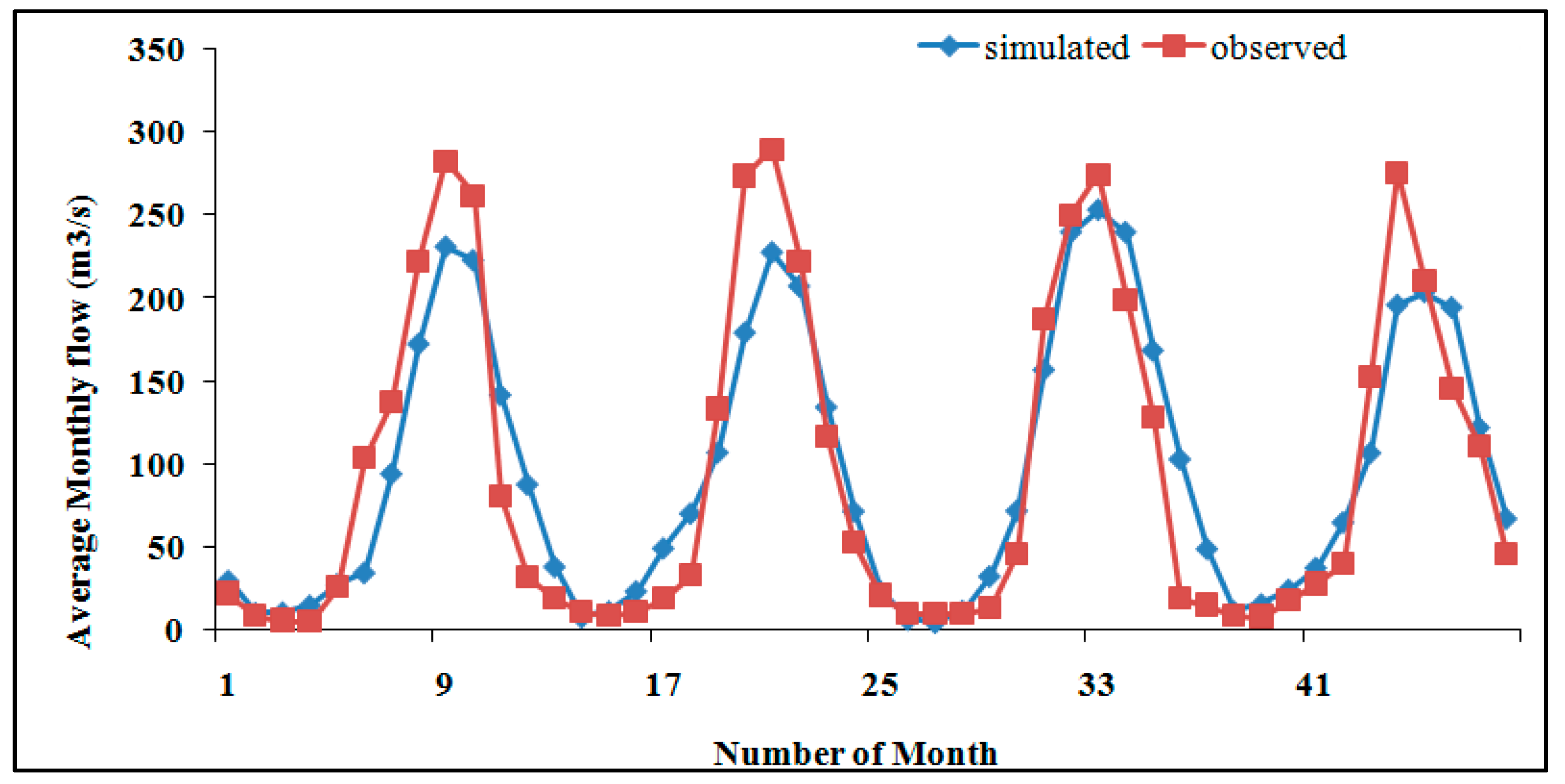

| Name | Years of Record | X [°] | Y [°] | Elevation [m asl] |
|---|---|---|---|---|
| Fincha’a | 1989–2018 | 9.57 | 37.37 | 2248 |
| Homi | 1987–2018 | 9.621 | 37.241 | 2371 |
| Shambu | 1981–2018 | 9.5712 | 37.1 | 2460 |
| Neshe | 1981–2018 | 9.723 | 37.268 | 2060 |
| Soil Name | Area Covered | SWAT Naming | |
|---|---|---|---|
| [ha] | [%] | ||
| Dystric Cambisols | 437.1643 | 0.14 | Bd31-2c-11 |
| Eutric Cambisols | 94,827.3963 | 29.57 | Be8-3c-24 |
| Cambic Arenosols | 35,365.7764 | 11.03 | Qc5-1c-182 |
| Eutric Nitosols | 113,078.3254 | 35.27 | Ne20-3b-160 |
| Chromic Vertisols | 35,579.3598 | 11.10 | Vc23-3a-262 |
| Water | 41,360.6536 | 12.90 | WR-192 |
| Sensor | Spatial Resolution | Acquisition Date | Image Quality | Path/Row |
|---|---|---|---|---|
| Landsat 5 TM | 30 m | 5 January1994 | 7 | 169/053 |
| Landsat 7 ETM | 30 m | 7 December 2004 | 9 | 169/053 |
| Landsat 8 OLI/TRIS | 30 m | 3 December 2018 | 9 | 169/053 |
| S. No. | Land Use Land Cover | SWAT LULC | SWAT Code |
|---|---|---|---|
| 1 | Cultivated Land | Agricultural land row crops | AGRR |
| 2 | Bare Soil | Barren | BARR |
| 3 | Forest Land | Forest-Evergreen | FRSE |
| 4 | Shrub Land | Forest-Mixed | FRST |
| 5 | Grass Land | Agricultural Land-Generic | AGRL |
| 6 | Settlement | Residential | URBN |
| 7 | Waterbody | Water | WATR |
| 8 | Wetland | Wetlands-Mixed | WETL |
| Slope | % Area | Area [ha] |
|---|---|---|
| 0–3 | 22.5 | 71,925.8021 |
| 3–8 | 30 | 95,965.2960 |
| 8–15 | 21 | 67,548.7056 |
| 15–30 | 18 | 57,980.1691 |
| >30 | 8.5 | 27,228.7031 |
| Sub-Basin | Number of HRUs | Dominant LULC | % Area |
|---|---|---|---|
| 1 | 19 | FRSE | 63.3 |
| 2 | 7 | uniform FRSE | 3.3 |
| 3 | 8 | uniform FRSE | 1.7 |
| 4 | 15 | FRSE | 3.3 |
| 5 | 16 | AGRR | 1.4 |
| 6 | 8 | uniform FRSE | 3.2 |
| 7 | 5 | FRSE | 1.4 |
| 8 | 10 | AGRR | 5.0 |
| 9 | 11 | WATR | 0.7 |
| 10 | 5 | AGRR | 0.4 |
| 11 | 9 | FRSE | 2.1 |
| 12 | 6 | AGRR | 0.8 |
| 13 | 14 | AGRR | 2.0 |
| 14 | 8 | AGRR | 4.1 |
| 15 | 6 | WATR | 0.1 |
| 16 | 14 | AGRR | 3.4 |
| 17 | 6 | AGRR | 0.1 |
| 18 | 9 | AGRR | 3.8 |
| Total | 176 | 100 |
| LULC | 1994 | 2004 | 2018 | 2018–1994 | ||||
|---|---|---|---|---|---|---|---|---|
| % | Area [ha] | % | Area [ha] | % | Area [ha] | % | Area [ha] | |
| Cultivated Land | 42.8 | 137,352.31 | 59.3 | 189,976.87 | 70.1 | 224,624.24 | +87,271.9 | +27.22 |
| Bare Soil | 1.7 | 5376.85 | 3.5 | 11,265.78 | 4.3 | 13,600.26 | +8223.4 | +2.57 |
| Forest Land | 33.5 | 107,283.40 | 13.0 | 41,714.20 | 1.2 | 3719.33 | −103,564.1 | −32.3 |
| Shrub Land | 10.8 | 34,565.07 | 7.2 | 22,925.81 | 1.2 | 3910.08 | −30,655.0 | −9.56 |
| Grass Land | 0.2 | 488.97 | 0.1 | 391.18 | 0.1 | 97.79 | −391.2 | −0.12 |
| Settlement | 0.1 | 262.66 | 0.2 | 525.32 | 0.4 | 1161.86 | +899.2 | +0.27 |
| Water Body | 10.3 | 33,101.79 | 14.3 | 45,707.42 | 18.6 | 59,563.98 | +26,462.2 | +8.25 |
| Wetland | 0.7 | 2217.63 | 2.5 | 8163.46 | 4.4 | 14,012.86 | +11,795.2 | +3.67 |
| Total | 100 | 320,648.68 | 100 | 320,045.70 | 100 | 348,016.75 | ||
| LULC | S | WL | SHL | WB | CL | GL | FL | BS | Total | User (%) |
|---|---|---|---|---|---|---|---|---|---|---|
| S | 8 | 0 | 1 | 0 | 1 | 0 | 2 | 0 | 12 | 66.67 |
| WL | 1 | 18 | 0 | 2 | 0 | 1 | 0 | 1 | 23 | 78.26 |
| SHL | 0 | 1 | 15 | 0 | 2 | 0 | 0 | 0 | 19 | 78.95 |
| WB | 1 | 0 | 1 | 21 | 0 | 0 | 1 | 0 | 24 | 87.50 |
| CL | 0 | 3 | 0 | 0 | 27 | 1 | 0 | 0 | 31 | 87.10 |
| GL | 0 | 0 | 0 | 0 | 0 | 15 | 3 | 2 | 20 | 75.00 |
| FL | 0 | 2 | 0 | 0 | 0 | 0 | 33 | 1 | 36 | 91.67 |
| BS | 0 | 0 | 0 | 0 | 0 | 2 | 0 | 16 | 20 | 100.00 |
| Total | 10 | 24 | 16 | 23 | 30 | 19 | 36 | 20 | 178 | OA = 86.06 |
| Producer’s (%) | 80.00 | 75.00 | 93.75 | 91.30 | 90.00 | 78.95 | 91.67 | 80 | Ka = 83.61 |
| LULC | S | WL | SHL | WB | CL | GL | FL | BS | Total | User’s (%) |
|---|---|---|---|---|---|---|---|---|---|---|
| S | 10 | 1 | 0 | 1 | 0 | 0 | 1 | 0 | 13 | 76.92 |
| WL | 0 | 35 | 1 | 0 | 2 | 0 | 0 | 0 | 38 | 92.11 |
| SHL | 1 | 0 | 32 | 0 | 0 | 0 | 0 | 1 | 34 | 94.12 |
| WB | 0 | 0 | 1 | 33 | 0 | 2 | 0 | 0 | 36 | 91.67 |
| CL | 0 | 0 | 0 | 0 | 40 | 0 | 2 | 1 | 43 | 93.02 |
| GL | 0 | 0 | 3 | 0 | 3 | 20 | 0 | 0 | 26 | 76.92 |
| FL | 0 | 1 | 0 | 1 | 0 | 2 | 34 | 0 | 38 | 89.47 |
| BS | 0 | 0 | 0 | 0 | 0 | 3 | 0 | 18 | 21 | 85.71 |
| Total | 11 | 37 | 37 | 35 | 45 | 27 | 37 | 20 | 249 | OA = 89.16 |
| Producer’s (%) | 90.91 | 94.59 | 86.49 | 94.29 | 88.89 | 74.07 | 91.89 | 90.00 | Ka = 87.43 |
| LULC | S | WL | SHL | WB | CL | GL | FL | BS | Total | User’s (%) |
|---|---|---|---|---|---|---|---|---|---|---|
| S | 15 | 0 | 0 | 0 | 1 | 2 | 0 | 0 | 18 | 83.33 |
| WL | 0 | 43 | 1 | 0 | 0 | 0 | 1 | 0 | 45 | 95.56 |
| SHL | 1 | 0 | 40 | 1 | 0 | 1 | 0 | 1 | 44 | 90.91 |
| WB | 0 | 1 | 0 | 41 | 1 | 0 | 0 | 0 | 43 | 95.35 |
| CL | 0 | 0 | 1 | 0 | 48 | 0 | 2 | 1 | 52 | 92.31 |
| GL | 0 | 1 | 0 | 2 | 0 | 30 | 0 | 0 | 33 | 90.91 |
| FL | 1 | 0 | 0 | 0 | 1 | 1 | 42 | 0 | 45 | 93.33 |
| BS | 0 | 1 | 1 | 0 | 0 | 0 | 1 | 35 | 38 | 92.11 |
| Total | 17 | 46 | 43 | 44 | 51 | 34 | 46 | 37 | 318 | OA = 92.45 |
| Producer’s (%) | 88.24 | 93.48 | 93.02 | 93.18 | 94.12 | 88.24 | 91.30 | 94.59 | Ka = 91.30 |
| R2 | NSE | PBIAS | |
|---|---|---|---|
| Calibration (1997–2004) | 0.86 | 0.85 | +1.13 |
| Validation (2005–2008) | 0.87 | 0.84 | −2.806 |
| Period | Average Flow [m3/s] | Change of Flow [m3/s] | ||||
|---|---|---|---|---|---|---|
| 1994 | 2004 | 2018 | 1994–2004 | 2004–2018 | 1994–2018 | |
| dry months | 10.72 | 15.89 | 25.86 | +5.2 | +9.5 | +14.6 |
| wet months | 132.67 | 167.85 | 194.67 | +35.2 | +26.8 | +62.0 |
| S. No. | Parameter | Definition | Fitted Value | Max_Value | Min_Value |
|---|---|---|---|---|---|
| 1 | SOL_K | Saturated Hydraulic conductivity | 0.24 | −0.8 | 0.8 |
| 2 | ALPHA_BF | Base flow alpha factor (days) | 0.85 | 0 | 1 |
| 3 | GW_DELAY | Ground water delay (days) | 51 | 30 | 450 |
| 4 | GWQMN | The threshold depth of water shallow aquifer | 0.3 | 0 | 2 |
| 5 | GW_REVAP | Groundwater revamp coefficient | 0.11 | 0 | 0.2 |
| 6 | ESCO | Soil evaporation compensation factor | 0.93 | 0.8 | 1 |
| 7 | CH_N2 | Manning’s roughness coefficient | 0.045 | 0 | 0.3 |
| 8 | CH_K2 | Effective hydraulic conductivity | 23.75 | 5 | 130 |
| 9 | ALPHA_BNK | Baseflow alpha factor for bank storage | 0.45 | 0 | 1 |
| 10 | SOL_AWC | Soil available water capacity | −0.17 | −0.2 | 0.4 |
| 11 | CN2 | SCS runoff Curve number for moisture condition II | −0.18 | −0.2 | 0.2 |
| 12 | SOL_BD | Moist bulk density | 0.105 | −0.5 | 0.6 |
Publisher’s Note: MDPI stays neutral with regard to jurisdictional claims in published maps and institutional affiliations. |
© 2021 by the authors. Licensee MDPI, Basel, Switzerland. This article is an open access article distributed under the terms and conditions of the Creative Commons Attribution (CC BY) license (https://creativecommons.org/licenses/by/4.0/).
Share and Cite
Kenea, U.; Adeba, D.; Regasa, M.S.; Nones, M. Hydrological Responses to Land Use Land Cover Changes in the Fincha’a Watershed, Ethiopia. Land 2021, 10, 916. https://doi.org/10.3390/land10090916
Kenea U, Adeba D, Regasa MS, Nones M. Hydrological Responses to Land Use Land Cover Changes in the Fincha’a Watershed, Ethiopia. Land. 2021; 10(9):916. https://doi.org/10.3390/land10090916
Chicago/Turabian StyleKenea, Urgessa, Dereje Adeba, Motuma Shiferaw Regasa, and Michael Nones. 2021. "Hydrological Responses to Land Use Land Cover Changes in the Fincha’a Watershed, Ethiopia" Land 10, no. 9: 916. https://doi.org/10.3390/land10090916
APA StyleKenea, U., Adeba, D., Regasa, M. S., & Nones, M. (2021). Hydrological Responses to Land Use Land Cover Changes in the Fincha’a Watershed, Ethiopia. Land, 10(9), 916. https://doi.org/10.3390/land10090916









